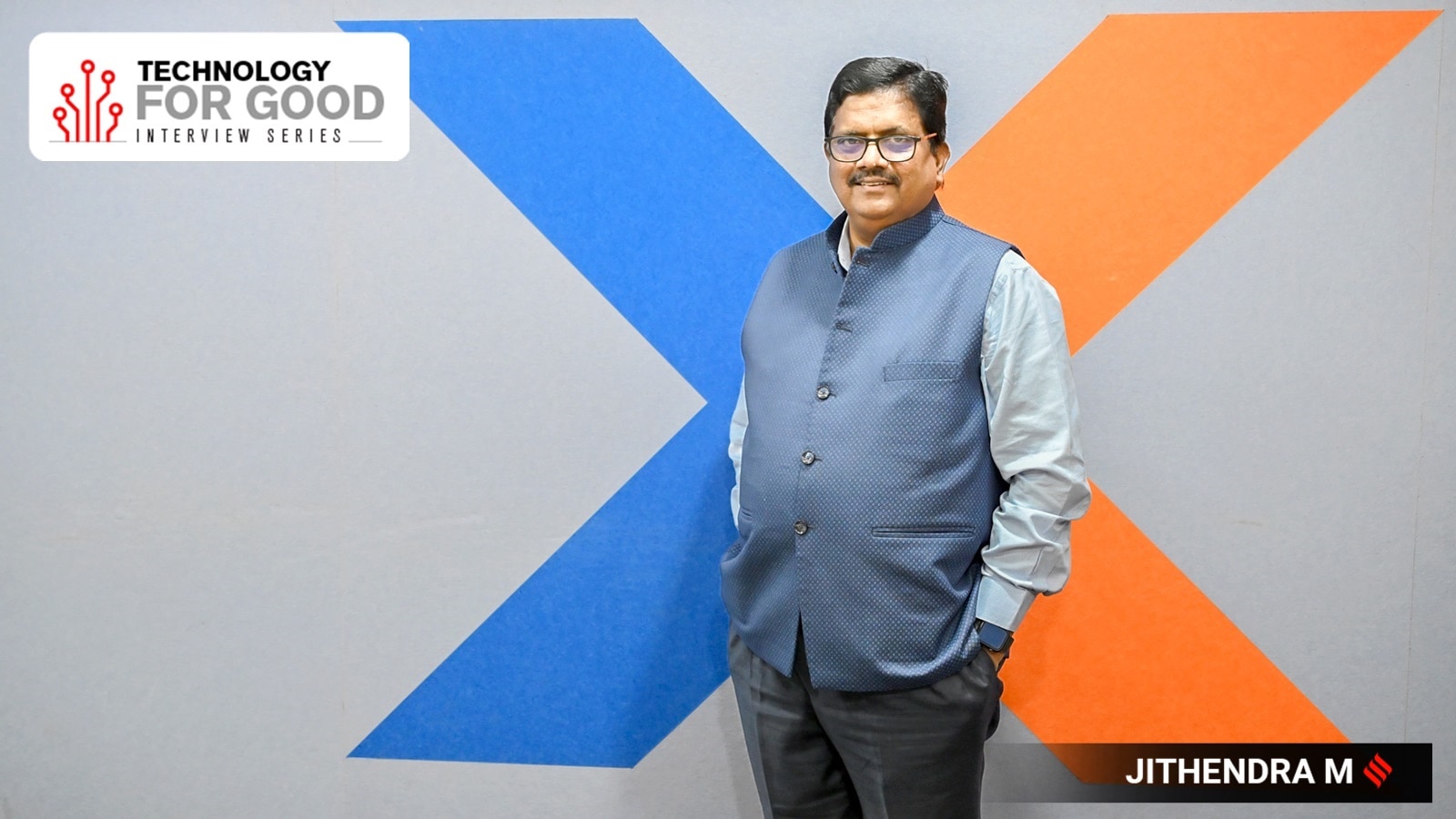BV Naidu is the Chairman of the Karnataka Digital Economy Mission (KDEM), an organisation working as a knowledge bridge between the Karnataka Government, IT industry, and tech sector in the state.
One of KDEM’s initiatives is the ‘Beyond Bengaluru’ programme, which aims to tap into the potential of emerging cities outside the state capital. By nurturing growth and attracting investments, it drives the tech economy in these emerging clusters.
He is also the founder of StartupXseed Ventures, funding deeptech, B2B, early-stage startups, and the founder of The GAIN, a non-profit accelerator focused on innovation.
A former director of the Software Technology Parks of India (STPI), an organisation under the Government of India, established to promote software exports from the country, BV Naidu has been a pivotal figure in the growth of the IT industry in Bengaluru.
BV Naidu spoke to indianexpress.com on his journey through the IT industry in India, the challenges incubators and startups face, and the role of governments in promoting tech clusters in Tier 2 and Tier 3 cities. Edited excerpts:
Venkatesh Kannaiah: What were some highlights of your journey in India’s IT industry?
BV Naidu: My career began in 1987 when I joined the then Department of Electronics, now the Ministry of Electronics and Information Technology. One of my proudest moments was sending India’s first email from my PC, an achievement marking the start of digital communications in the country. I was part of the founding team of ERNET (Education and Research Network of India), which connected universities and research institutions, laying the foundation for India’s internet infrastructure. The project was supported by the United Nations Development Programme (UNDP).
Story continues below this ad
One unforgettable moment was demonstrating the working of an email to then Prime Minister Chandra Shekhar. It is possible he was the first Indian prime minister to engage with this technology, and I still recall the excitement as we showcased this new tool.
In 1992, I moved to Bengaluru as part of the Software Technology Parks of India (STPI) to tackle the software industry’s biggest bottlenecks. At the time, companies faced delays of up to a year to secure a 64 kbps line, essential for global connectivity. Companies like IBM and Wipro needed reliable communication to compete internationally. I helped establish India’s first commercial internet service in Bangalore’s Electronic City and provided instant connectivity to small and medium-sized companies.
I also broke the monopoly of the then Videsh Sanchar Nigam Limited (VSNL) by setting up an international satellite gateway in Bengaluru’s Electronics City to connect Bengaluru directly to the US, bypassing traditional barriers, and also established a multi-access radio network to link software firms’ offices in the city to this infrastructure. This helped them communicate seamlessly with overseas markets. In 1993, I facilitated India’s first video conferencing, connecting Bengaluru with WorldCom’s CEO in New York.
These early initiatives were about building trust in India’s capabilities.
Story continues below this ad
Venkatesh Kannaiah: You have been with Software Technology Parks of India for 15 years. Can you tell us the changes you brought about and their impact?
BV Naidu: As the head of STPI Bangalore, I saw an opportunity to redefine the organisation’s role. STPI was tasked with promoting software exports and monitoring compliance. But I had a vision of it as a proactive enabler, removing barriers to industry growth.
One of my key interventions was helping streamline customs processes. Software companies needed duty-free imports, but delays and inefficiencies were common. I took responsibility for bonding and debonding imported goods, ensuring my team handled these processes efficiently. This shielded companies from customs-related hassles, allowing them to focus on the core business of software exports.
From 1998-2001, I expanded STPI’s reach beyond Bengaluru, establishing centres in Mysore, Mangalore, and Hubli. From 2004-2006, I expanded the footprint of STPI to Tirupati, Vijayawada, Visakhapatnam, and Kakinada. These centres provided communication infrastructure, regulatory support, and incubation facilities.
Story continues below this ad
Beyond infrastructure, I helped draft Karnataka’s first IT policy in 1998 and launched BangaloreIT.com in 1998, an event that showcased the city’s tech capabilities.
As a founding trustee of the International Institute of Information Technology, Bangalore (IIIT-B), I helped establish a model for industry-academia collaboration. These initiatives transformed Bengaluru into a global tech hub and set a precedent for other cities.
Venkatesh Kannaiah: What are your thoughts on the effectiveness of different incubation models?
BV Naidu: Over the years, I have closely observed the strengths and weaknesses of incubation models in India. They are of three types: academic-led, government-supported, and corporate, each with different challenges.
Story continues below this ad
Academic incubators, hosted by institutions like IITs and IIMs, struggle to translate research into market-friendly products. Professors, while brilliant in their fields, often lack a commercial outlook needed to guide startups to scale. Despite significant government funding, the return on investment is low. There are exceptions like IIM Ahmedabad, IIT Chennai, and IISc Bangalore, but overall, academic incubators fall short of their potential. There is a certain disconnect between theoretical research and practical applications.
Government-supported incubators and some backed by industry organisations have substantial budgets and infrastructure. However, many turn into co-working spaces or event management hubs, losing sight of their core mission to nurture startups. They offer good facilities, but the focus often shifts to branding rather than fostering entrepreneurial success. This dilution of purpose limits their impact.
Corporate incubators run by multinational firms have deep pockets and brand recognition. But some of these incubators are partly corporate branding initiatives, and there may not be sufficient commitment to innovation. While some corporate incubators perform well, many prioritise their parent company’s image over tangible outcomes.
We need more and more tech practitioner/entrepreneur-driven incubators for passion to take centre-stage and make a difference.
Story continues below this ad
Venkatesh Kannaiah: Tell us about your accelerator, The GAIN, and how it is different?
BV Naidu: Our approach at The GAIN, which was started in 2019, has been different. We ran a cohort programme with the Government of India, supporting 29 companies without taking equity, a rarity in the incubation space. Our acceleration support outperformed larger, better-funded programmes, earning recognition from the Startup India Seed Fund. We also pioneered cross-border acceleration, bringing Korean and Israeli startups to Bengaluru. These startups, often tech-savvy but lacking market access, found joint venture partners in India.
I believe the key to effective incubation lies in passion and professionalism, unlike academic or corporate models, where external priorities often dominate.
Venkatesh Kannaiah: As the Chairman of the Karnataka Digital Economy Mission, what is your focus?
Story continues below this ad
BV Naidu: You must understand the logic behind the founding of the Karnataka Digital Economy Mission (KDEM). Technology moves at a breakneck speed, and government officials often struggle to keep pace with the changes. Moreover, their job roles keep changing. KDEM is a unique industry initiative with the participation of various industry associations working with the support of the government. This has attracted corporate talent to work alongside the government, bridging the gap between industry needs and support policy implementation. It is like a knowledge bridge, and the goal is to sustain Karnataka’s leadership in the digital economy.
KDEM drives innovation across three verticals: IT/Global Capability Centres (GCCs), Electronic System Design and Manufacturing (ESDM), and startups and innovation. We also focus on two horizontals: talent development and the mission of ‘Beyond Bengaluru’.
Startups in regions like Mysore, Mangalore, and Hubli often feel that they are not up to the mark. To change this perception, we identified over 400 startups in these clusters and launched initiatives to energise them. Through the Karnataka Accelerator Network, we established a mother accelerator in Bengaluru that supports regional accelerators in smaller cities. This network has been a game-changer, with over 40% of participants in the Elevate programme — a government-backed startup initiative — coming from Beyond Bengaluru clusters.
We also organise tech shows to showcase these startups, much like the BangaloreIT.com events, which began in 1998 and have now transformed into the Bangalore Tech Summit, a large global event. These events at these clusters put regional startups in the spotlight, attracting investors and partners. We also promote global tech centres, similar to Bengaluru’s ITPL, to draw anchor companies to these regions. For instance, we helped IBM establish a presence in Mysore, where they now employ 600 people, with plans to scale to 2,000 by next year. This creates a snowball effect, encouraging other companies to follow suit.
Story continues below this ad
We are helping create a cluster seed fund under KITVEN (Karnataka IT fund). This fund combines government contributions with investments from local industry leaders, ensuring that regional startups have the capital and mentorship needed to compete. By focusing on these emerging tech clusters, we are democratising and decentralising innovation.
Our approach is industry-driven, with senior corporate leaders guiding each vertical. This ensures that our initiatives are grounded in real-world needs.
Venkatesh Kannaiah: Should the development of tech clusters at Tier-2 and Tier-3 cities be left to market forces, or should the government play a role?
BV Naidu: I firmly believe that markets alone cannot drive the development of emerging tech clusters, what others call Tier-2 and Tier-3 cities. The government must act as an enabler, creating the conditions for growth. I have stopped using the terms Tier-2 and Tier-3 because they demean these regions.
Instead, I call them emerging tech clusters, emphasising their potential.
Take Mysore as an example. We attracted IBM by crafting a value proposition of lower operational costs, reduced attrition rates, and access to talent. My team at KDEM worked closely with IBM to demonstrate the return on investment. This sparked a ripple effect, drawing other companies to the region. The government is also creating a two-lakh square feet Global Tech Centre in Mysore, and it has generated a lot of interest in the industry. The Mysore cluster is also bringing in US companies to the Chamarajanagar district of Karnataka, which is generally considered a backward district. In Mangalore, we have encouraged local entrepreneurs to build high-quality co-working spaces.
These outcomes do not happen by chance. Governments must show the path by providing infrastructure, attracting anchor companies, and fostering talent. In Hubli and Belagavi, we are replicating this model, creating global tech centres and co-working spaces to drive growth. Small incentives like rental reimbursement, reimbursement of PF, power tariff concession, and stamp duty exemptions on land are helpful, but companies do not come for incentives alone. They look at long-term ROI — lower costs, stable talent, and market access. Without government intervention to seed these ecosystems, progress would be slow.
Venkatesh Kannaiah: How do you see Bengaluru’s tech ecosystem evolving over the next 10 years?
BV Naidu: I am optimistic about Bengaluru’s future as a tech hub. The city contributes over 35-40% of India’s tech output, and despite infrastructure challenges, like any other growing city, its talent pool and growing domestic market will sustain its growth. Initiatives in emerging fields like quantum computing and robotics, such as the ARTPARK at IISc, are positioning Bengaluru at the forefront of innovation. Beyond Bengaluru, clusters like Mysore, Mangalore, and Hubli are adding to this momentum. Together, Karnataka will maintain its leadership in India’s tech landscape.
Venkatesh Kannaiah: What are your thoughts on AI and its impact on jobs?
BV Naidu: When it comes to AI and jobs, I am not concerned. I have seen the industry navigate disruptions like Y2K in 2000, the Dotcom bust in 2001-2002, and the Lehman Brothers crash in 2008. Each time, people feared the end of tech jobs. Each time, new opportunities emerged. AI will follow a similar path, creating new roles and skills if we embrace change. Moreover, it provides a bigger platform for our startups to perform. I am of the school of thought that sees AI as a catalyst for innovation, not a threat.
Some worry about job losses, but I believe reskilling is the key. By equipping our workforce with AI-related skills, we can turn this disruption into an opportunity.
Venkatesh Kannaiah: How has the government-industry-academia relationship evolved, and what makes Karnataka unique?
BV Naidu: In Karnataka, the government-industry-academia relationship is a model for others. I’ve been part of this transformation, starting with my time at STPI, when we requested Narayana Murthy in 1997 to be the chairman of the STPI Executive Board. We had ensured that industry voices shaped our strategies. Now, all the vision groups of the Government of Karnataka are driven by industry leaders, and initiatives like KDEM have cemented this collaboration. Unlike other states, where government, industry, and academia often operate in silos, in Karnataka, it is a tight-knit partnership.
Other states like Uttar Pradesh and Maharashtra are looking to replicate KDEM’s model, showing that we are doing things right.







